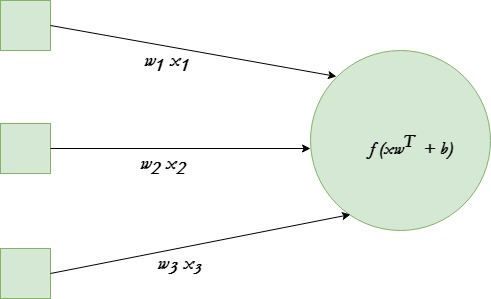神经网络是深度学习的核心,深度学习是一个在许多不同领域都有实际应用的领域。如今,神经网络已用于图像分类,语音识别,对象检测等。现在,让我们尝试了解所有这些最新技术背后的基本单位。
单个神经元将给定的输入转换为某些输出。根据给定的输入和分配给每个输入的权重,确定神经元是否触发。假设神经元具有3个输入连接和1个输出。

在给定的示例中,我们将使用tanh激活函数。
最终目标是为该神经元找到最佳的权重集,以产生正确的结果。通过使用几个不同的训练示例训练神经元来做到这一点。在每个步骤中,计算神经元输出中的误差,然后反向传播梯度。计算神经元输出的步骤称为正向传播,而计算梯度的步骤称为反向传播。
下面是实现:
# Python program to implement a
# single neuron neural network
# import all necessery libraries
from numpy import exp, array, random, dot, tanh
# Class to create a neural
# network with single neuron
class NeuralNetwork():
def __init__(self):
# Using seed to make sure it'll
# generate same weights in every run
random.seed(1)
# 3x1 Weight matrix
self.weight_matrix = 2 * random.random((3, 1)) - 1
# tanh as activation function
def tanh(self, x):
return tanh(x)
# derivative of tanh function.
# Needed to calculate the gradients.
def tanh_derivative(self, x):
return 1.0 - tanh(x) ** 2
# forward propagation
def forward_propagation(self, inputs):
return self.tanh(dot(inputs, self.weight_matrix))
# training the neural network.
def train(self, train_inputs, train_outputs,
num_train_iterations):
# Number of iterations we want to
# perform for this set of input.
for iteration in range(num_train_iterations):
output = self.forward_propagation(train_inputs)
# Calculate the error in the output.
error = train_outputs - output
# multiply the error by input and then
# by gradient of tanh funtion to calculate
# the adjustment needs to be made in weights
adjustment = dot(train_inputs.T, error *
self.tanh_derivative(output))
# Adjust the weight matrix
self.weight_matrix += adjustment
# Driver Code
if __name__ == "__main__":
neural_network = NeuralNetwork()
print ('Random weights at the start of training')
print (neural_network.weight_matrix)
train_inputs = array([[0, 0, 1], [1, 1, 1], [1, 0, 1], [0, 1, 1]])
train_outputs = array([[0, 1, 1, 0]]).T
neural_network.train(train_inputs, train_outputs, 10000)
print ('New weights after training')
print (neural_network.weight_matrix)
# Test the neural network with a new situation.
print ("Testing network on new examples ->")
print (neural_network.forward_propagation(array([1, 0, 0])))
输出 :
Random weights at the start of training
[[-0.16595599]
[ 0.44064899]
[-0.99977125]]
New weights after training
[[5.39428067]
[0.19482422]
[0.34317086]]
Testing network on new examples ->
[0.99995873]